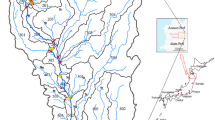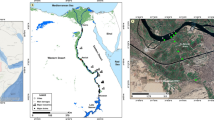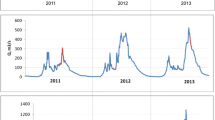Abstract
The Selenga River contributes to 50% of the total inflow to Lake Baikal. Large tracts of the Selenga River Basin have been developed for industry, urbanization, mining, and agriculture, resulting in the release of suspended solids (SS) that affect downstream water quality and primary productivity. This study addressed SS as the main factor controlling pollutant transport and the primary indicator of land degradation in the Selenga River system. Tributaries with larger areas dedicated to agricultural use had higher SS concentrations, reaching 862 mg L−1, especially during the high runoff and intensive cultivation season. Although the large SS flux was detected in the main river, the small tributaries were distinguished by high SS concentrations. The high SS concentration corresponded to widespread development in the watershed. Watersheds with high potential of SS release are sensitive to intensive land uses. SS in the river system had a constant elemental composition consisting mainly of Fe and Al oxides, indicating that surface soils were major constituents of the tributary SS. Three minor heavy metals (Zn, Cu, and Cr) appeared in high concentrations downstream of urban and mining areas (two- to sixfold increases), indicating that these contaminants are carried by SS. At two tributary junctions, the concentration of contaminants on the SS decreased due to a large influx of SS with low heavy metal contents. Changes in electric conductivity and pH at downstream of tributary junctions enhanced the sedimentation of SS and the removal of contaminants from the water phase after aggregation of the SS. Land use changes in the tributary watersheds are major controlling factors for the fate of contaminants in the river system.








Similar content being viewed by others
References
Altansukh O, Whitehead P, Bromley J (2012) Spatial patterns and temporal trends in the water quality of the Tuul River in Mongolia. Energy Environ Res 2:62–78
Bilotta GS, Brazie RE (2008) Understanding the influence of SS on water quality and aquatic biota. Water Res 42:2849–2861
Brumbaugh WG, Tillitt DE, May TW, Javzan Ch, Komov VT (2013) Environmental survey in the Tuul and Orkhon River basins of north-central Mongolia, 2010: metals and other elements in streambed sediment and floodplain soil. Environ Monit Assess 185:8991–9008
Byambaa B, Todo Y (2011) Technological impact of placer gold mine on water quality: case of Tuul River valley in the Zaamar Goldfield, Mongolia. World Acad Sci Eng Technol 51:167–171
Chalov SR, Zavadsky AS, Belozerova EV, Bulacheva MP, Jarsjo J, Thorslund J, Yamkhin J (2012) Suspended and dissolved matter fluxes in the upper Selenga River Basin. Geogr Environ Sustain 02(05):78–94
Chalov SR, Jarsjo J, Kasimov NS, Romanchenko AO, Pietron J, Thorslund J, Promakhova EV (2015) Spatio-temporal variation of sediment transport in the Selenga River Basin, Mongolia and Russia. Environ Earth Sci 73:663–680. doi:10.1007/s12665-014-3106-z
Chebykin EP, Goldberg EL, Kulikova NS (2010) Elemental composition of suspended particles from the surface waters of Lake Baikal in the zone by the Selenga River. Russian Geol Geophys 51:1126–1132. www.elsevier.com/locate/rgg
Chebykin EP, Sorokovikova LM, Vtomberg I, Rasskazov SV, Khodzher TV, Grachev MA (2012) Current state of the Selenga River waters in the Russian Territory concerning major components and trace elements. Chem Sustain Dev 20:561–580
Dalai B, Ishiga H (2013) Geochemical evaluation of present-day Tuul River sediments, Ulaanbaatar basin, Mongolia. Environ Monit Assess 185:2869–2881. doi:10.1007/s10661-012-2757-z
Dhanakumar S, Murthy KR, Solaraj G, Mohanraj R (2013) Heavy-metal fractionation in sediments of the Cauvery River Estuarine region, Southeastern Coast of India. Arch Environ Contam Toxicol 65:14–23. doi:10.1007/s00244-013-9886-4
Farrington JD (2000) Environmental problems of placer gold mining in the Zaamar Goldfield, Mongolia. World Placer J vol 1. www.mine.mn
Farrington JD (2005) The impact of mining activities on Mongolia’s protected areas: a status report with policy recommendations. Integr Environ Assess Manag 1(3):283–289
Grayson R, Tumenbayar B (2005) The role of placer mining companies in the State-sponsored gold rush in Mongolia. World Placer J vol 5. www.mine.mn
Hartwig M, Theuring P, Rode M, Borchardt D (2012) Suspended sediments in the Kharaa River catchment (Mongolia) and its impact on hyporheic zone functions. Environ Earth Sci 65:1535–1546. doi:10.1007/s12665-011-1198-2
Itoh M, Takemon Y, Makabe A, Yoshimizu C, Kohzu A, Ohte N, Tumurskh D, Tayasu I, Yoshida N, Nagata T (2011) Evaluation of wastewater nitrogen transformation in a natural wetland (Ulaanbaatar, Mnogolia) using dual-isotope analysis of nitrate. Sci Total Environ 409:1530–1538. www.elsevier.com/locate/scitotenv
Karpoff BS, Roscoe WE (2005) Report on placer gold properties in Tuul Valley, Zaamar Goldfield, Mongolia. Prepared for Khan Resources INC. www.rpancan.com
Karthe D, Heldt S, Houdret A, Borchardt D (2014) IWRM in a country under rapid transition: lessons learnt from the Kharaa River Basin, Mongolia. Environ Earth Sci 73:681–695. doi:10.1007/s12665-014-3435-y
Kratz DA, Ibisch RB, Avylush S, Enkhbayar G, Nergui S, Borchartdt D (2010) Impact of open placer gold mining on aquatic communities in rivers of the Khentii Mountains, North-East Mongolia. Mong J Biol Sci 8(1):41–50
Lambin EF, Geist HJ, Lepers E (2003) Dynamics of land-use and land-cover change in Tropical Regions. Annu Rev Environ Resour 28:205–241
Lane CR, Anenkhonov O, Liu H, Autrey BC, Chepinoga V (2015) Classification and inventory of freshwater wetlands and aquatic habitats in the Selenga River Delta of Lake Baikal, Russia, using high-resolution satellite imagery. Wetlands Ecol Manage 23:195–214. doi:10.1007/s11273-014-9369-z
Ministry of Environment and Green Development (2012) Orkhon River Basin integrated water resources management assessment report, chapter: natural condition and land use. Bron J, Linden Win van der
Ministry of Environment and Green Development (2012) Tuul River Basin integrated water resources management assessment report, chapter: natural condition and land use. Bron J, Linden Win van der
Nadmitov B, Hong S, Kang SI, Chu JM, Gomboev B, Janchivdorj L, Lee CH, Khim JS (2015) Large-scale monitoring and assessment of metal contamination in surface water of the Selenga River Basin (2007–2009). Environ Sci Pollut Res 22:2856–2867. doi:10.1007/s11356-014-3564-6
Ouedraogo I, Tigabu M, Savadogo P, Compaoré H, Odén PC, Ouadba JM (2010) Land cover change and its relation with population dynamics in Burkina Faso, West Africa. Land Degrad Dev 21:453–462
Plyusnin AM, Kislitsina LB, Zhambalova DI, Peryazeva EG, Udodov YN (2008) Development of the chemical characteristic of ground water at the delta of the Selenga River. Geochem Int 46(3):288–295
Potemkina TG, Potemkin VL (2014) Sediment load of the main rivers of Lake Baikal in a changing environment (east Siberia, Russia). Quatern Int 380–381:342–349
Priess JA, Schweitzer C, Wimmer F, Batkhishig O, Mimler M (2011) The consequences of land-use change and water demands in Central Mongolia. Land Use Policy. 28:4–10. www.elsevier.com/locate/landusepol. doi:10.1016/j.landusepol.2010.03.002
Priess JA, Schweitzer C, Batkhishig O, Koschitzki T, Wurbs D (2015) Impacts of agriculture land-use dynamics on erosion risks and options for land and water management in Northern Mongolia. Environ Earth Sci 73:697–708. doi:10.1007/s12665-014-3380-9
Rabodonirina S, Net S, Ouddane B, Merhaby D, Dumoulin D, Popescu T, Ravelonandro P (2015) Distribution of persistent organic pollutants (PAHs, Me-PAHs, PCBs) in dissolved, particulate and sedimentary phases in freshwater systems. Environ Pollut 206:38–48
Ryan PA (1991) Environmental effects of sediment on New Zealand streams: a review. NZ J Mar Freshwat Res 25:207–221
Stevenson JR, Villoria N, Byerlee D, Kelley T, Maredia M (2013) Green revolution research saved an estimated 18–27 million hectares from being brought into agricultural production. Proc Natl Acad Sci 110(21):8363–8368. doi:10.1073/pnas.1208065110
Stubblefield A, Chandra S, Eagan S, Tuvshinjargal D, Davaadorzh G, Gilroy D, Sampson J, Thorne J, Allen B, Hogan Z (2005) Impact of gold mining and land use alterations on the water quality of Central Mongolian Rivers. Int Environ Assess Manag 1(4):365–373
Tansel B, Rafiuddin S (2016) Heavy metal content in relation to particle size and organic content of surficial sediments in Miami River and transport potential. Int J Sedim Res. doi:10.1016/j.ijsrc.2016.05.004
Theuring P, Rode M, Behrens S, Kirchner G, Jha A (2013) Identification of fluvial sediment sources in the Kharaa River catchment, Northern Mongolia. Hydrol Process 27:845–856
Theuring P, Collins AL, Rode M (2015) Source identification of fine-grained suspended sediment in the Kharaa River basin, northern Mongolia. Sci Total Environ 526:77–87. www.elsevier.com/locate/scitotenv
Thorslund J, Jarsjo J, Chalov SR, Belozerova EV (2012) Gold mining impact on riverine heavy metal transport in a sparsely monitored region: the upper Lake Baikal Basin case. J Environ Monit 14:2780–2792. doi:10.1039/c2em30643c
Tornqvist R, Jarsjo J, Pietron J, Bring A, Rogberg P, Asokan SM, Destouni G (2014) Evolution of the hydro-climate system in the Lake Baikal basin. J Hydrol 519:1953–1962
Twyman RM (2005) Sample dissolution for elemental analysis: Wet digestion. Encyclopedia of analytical science, 2nd edn, vol 8, pp 146–153
UNDP (United Nations Development Programme) (2011) From vulnerability to sustainability: Environment and human development. Mongolian human development report 2011. Saurabh Sinha, Khuldorj Balganjav. UN house-Orient Plaza, Ulaanbaatar. www.un-mongolia.mn/undp
UNDP-GEF (United Nations Environment Programme and the Global Environment Facility project) (2012) Integrated natural resource management in the Baikal Basin transboundary ecosystem. Tumurchudur S, Jadambaa D
UNEP-NISD (United Nations Environment Programme and Network if Institutions for Sustainable Development partnership project) (2008) Integrated water management model on the Selenga River Basin. Mun Y, Ko I.H, Janchivdorj L, Gomboev B, Kang S.I, Lee C.H
UNOPS (United Nations Office for Project Services) (2013) Lake Baikal Basin transboundary diagnostic analysis. Marijinisen A.E
Walling DE (2006) Human impact on land-ocean sediment transfer by the world’s rivers. Geomorphology 79:192–216. www.elsevier.com/locate/geomorph
Walling DE, Fang D (2003) Recent trends in the suspended sediment loads of the world’s rivers. Glob Planet Change 39:111–126. www.elsevier.com/locate/gloplacha
Wisconsin State Lab of Hygiene (1993) Total suspended solids, mass balance (Dried at 103–105 °C) and volatile suspended solids (ignited at 550 °C). Environmental Sciences Section, Inorganic Chemistry Unit
World Bank (2010) Managing land and water to feed nine billion people and protect natural systems. In: Development and climatic change, World development report 2010, The World Bank, Washington DC
Acknowledgements
This study was supported by Grant-in-Aid for Scientific Research (B), Grant No. 25304001 from Japan Society for the Promotion of Science. The authors also thank to Ms. Batdulam B., Mr. Galdmaa, D., Ms. Bolormaa T. National University of Mongolia is appreciated by the research support.
Author information
Authors and Affiliations
Corresponding author
Rights and permissions
About this article
Cite this article
Myangan, O., Kawahigashi, M., Oyuntsetseg, B. et al. Impact of land uses on heavy metal distribution in the Selenga River system in Mongolia. Environ Earth Sci 76, 346 (2017). https://doi.org/10.1007/s12665-017-6664-z
Received:
Accepted:
Published:
DOI: https://doi.org/10.1007/s12665-017-6664-z




